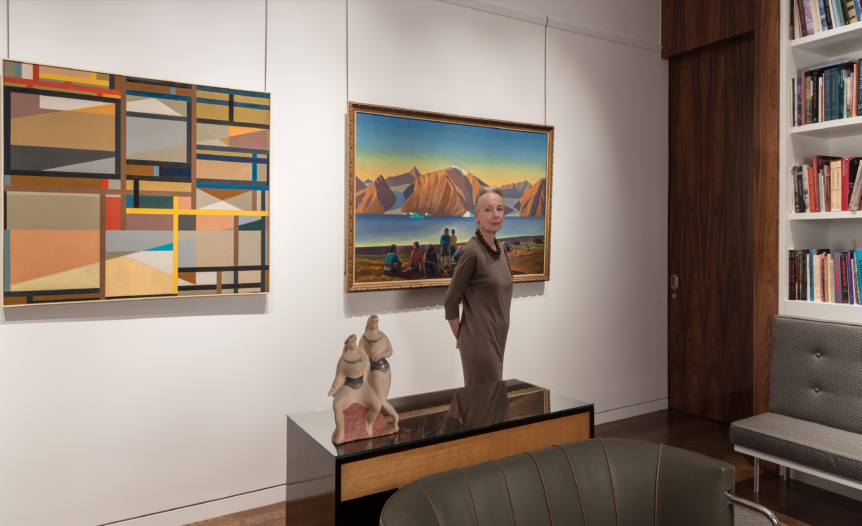ON ART DEALER AND COLLECTOR DEEDEE WIGMORE AND HER AESTHETIC AMBIDEXTERITY
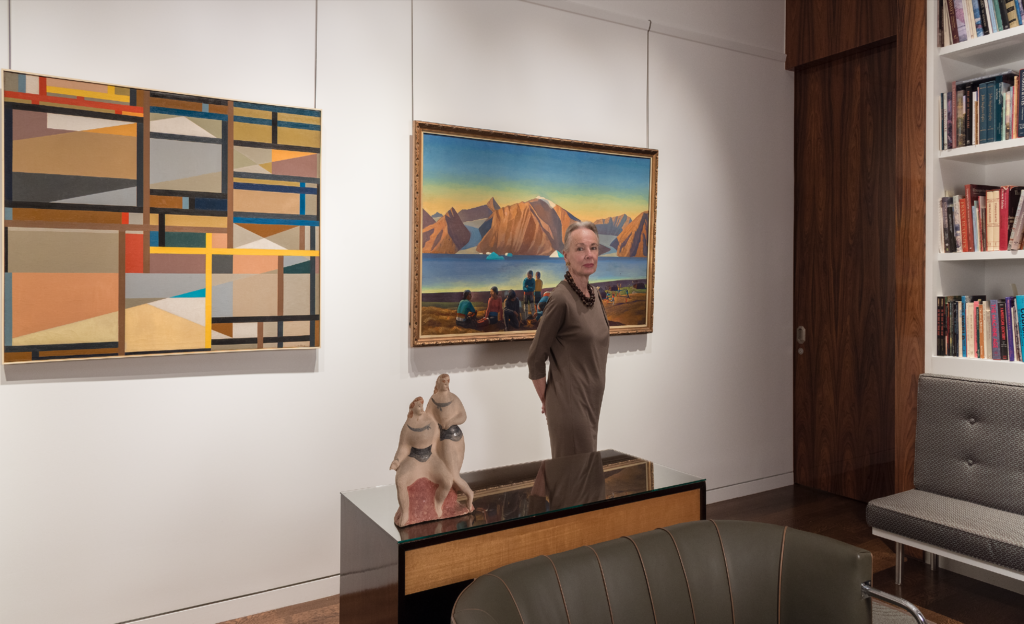
Deedee Wigmore in the viewing room of her New York gallery, D. Wigmore Fine Art. Behind her are Centennial by Ilya Bolotowsky (1907–1981), 1949, and Sunday Evening, Greenland by Rockwell Kent (1882–1971), 1935– 1944. The sculpture on the table is Two Women (Seated and Standing) by Elie Nadelman (1882– 1946), c. 1933. Photograph by Joshua Nefsky. Except as noted, photographs are courtesy of D. Wigmore Fine Art, New York.
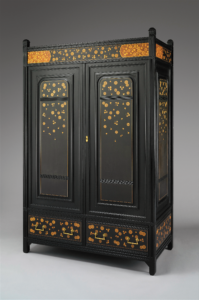
Wigmore found inspiration for her collection of American aesthetic movement furniture in this piece at the Met Museum, a wardrobe made by Herter Brothers, New York, 1875–1883. Metropolitan Museum of Art, gift of Kenneth O. Smith; photograph courtesy of the Metropolitan Museum of Art.
You could say that Deedee Wigmore is a time traveler, of sorts. At home, she dwells in the nineteenth century. The apartment she shares with her husband, philanthropist Barrie A. Wigmore, features a museum-worthy collection of American aesthetic movement furniture and ceramics, as well as paintings by artists of the Hudson River school. At the office—her gallery, D. Wigmore Fine Art, located on Fifty-Seventh Street in New York in a tower adjacent to Carnegie Hall—she inhabits the twentieth century. The American artists whose work she handles range from early modernists to American Scene painters to pre- and postwar abstractionists. Alice Cooney Frelinghuysen, decorative arts curator in the American Wing of the Metropolitan Museum of Art and a Wigmore friend of many years, is highly impressed by this elastic acumen. “It’s astonishing,” she says “And Deedee brings the same well-honed eye and scholarly rigor to both her collection and her gallery.”
Over the course of her career, Wigmore has become accustomed to dramatic changes in milieux. After earning her undergraduate degree at the University of Oregon, she went on to Oxford University to study the fine arts. She then left that tranquil town of limestone cloisters for the concrete canyons of New York. There she began her professional life in the 1970s at M. Knoedler and Company—at the time (long before its inglorious demise a decade ago) one of the most respected art galleries in the world. “The standards were very high,” Wigmore says. “There was a feeling that if you were an art dealer you had to prove you had judgment and taste every day.”
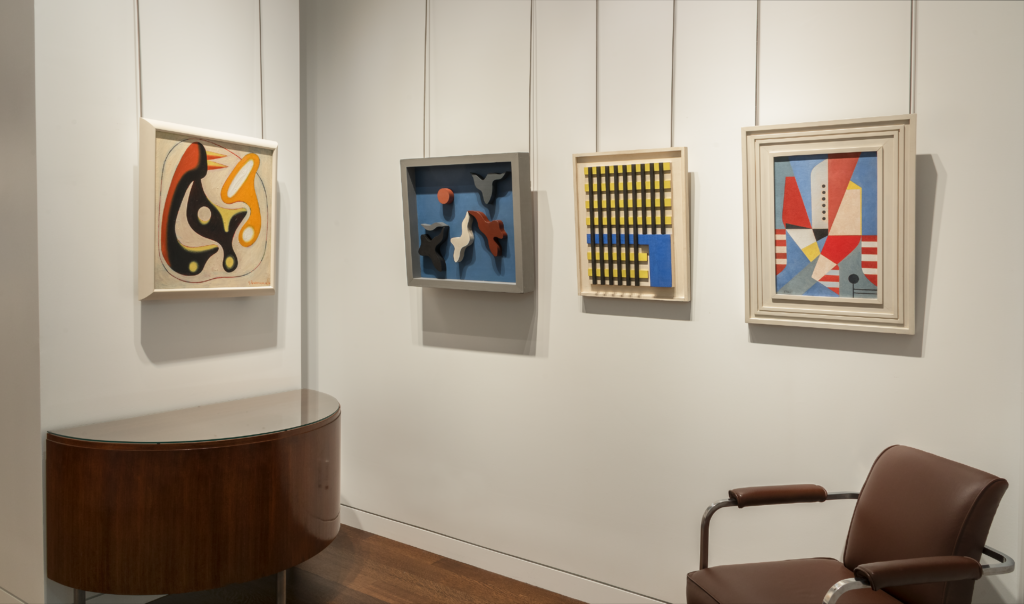
Gallery installation at D. Wigmore Fine Art that includes the work of Charles Biederman (1906– 2004) and Charles Green Shaw (1892–1974), two abstract artists of the 1930s and 1940s whose estates the gallery represents. Nefsky photograph.
She learned more and more on the job. Knoedler, she says, dealt in only “the best of the best,” and Wigmore had firsthand experience with great art of most every period, style, and genre. As well, the gallery boasted a peerless art history library—so extensive that, as Wigmore recalls, it had a full-time staff of four. “Whenever you became interested in a topic, you could research it thoroughly,” she says. “It was a great way to identify a pathway for yourself.” Later Wigmore took a job as sales manager at another legendary art-dealing firm, Kennedy Galleries, where the goal, she says, was “to offer a full historical profile of what America had achieved in the arts” with specialists in western art, Audubon prints, maps, the Hudson River school, and on and on. “I learned so much working with the different departments,” Wigmore says.
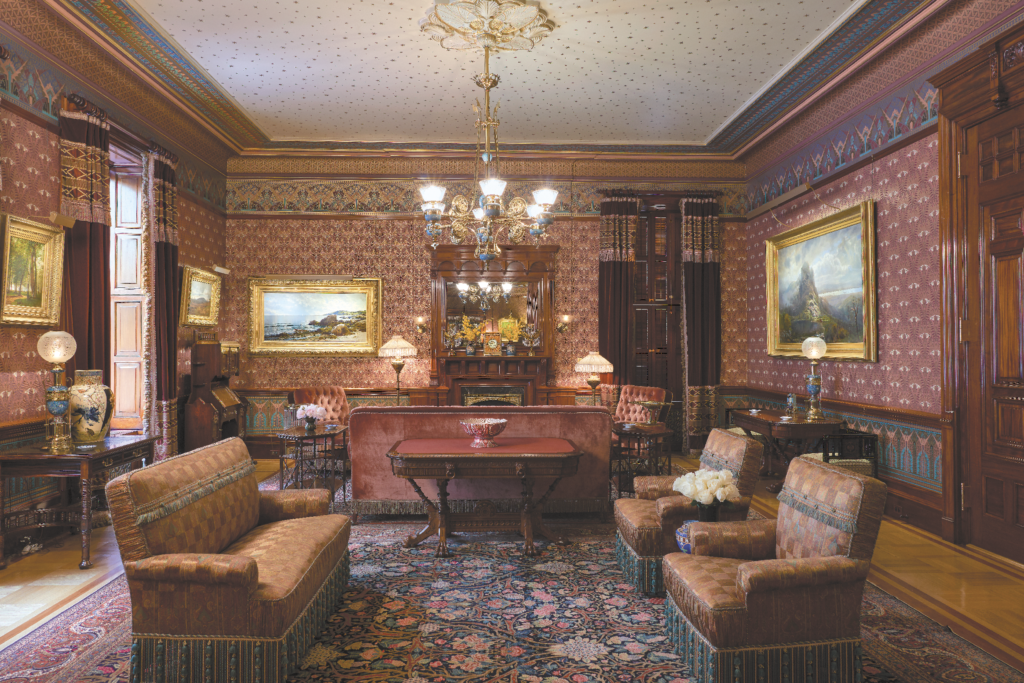
One of the rooms in the apartment at the Dakota on Manhattan’s Upper West Side that Deedee Wigmore shares with her husband, Barrie. The apartment is appointed with aesthetic movement furniture and paintings by artists of the Hudson River school. Photograph by Michel Arnaud, courtesy of the Metropolitan Museum of Art.
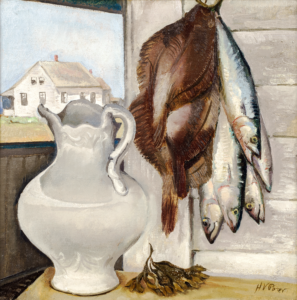
Fish, White Pitcher, Truro, MA by Henry Varnum Poor (1888–1970), c. 1933–1934. Estate of Henry Varnum Poor; photograph by Noel Allum.
She soon knew enough to step out on her own, opening her gallery in 1980. Wigmore had become interested in American artists who had come to the fore in the 1930s and ‘40s. She saw that many older dealers, leery of artists who had associated with Communism, were reluctant to handle the work of almost any artists of the period. “That was a leftover from McCarthyism,” Wigmore says. The first artist whose estate she handled was Joe Jones, a working-class hero best known for his paintings of midwestern farm laborers. Other leftist artists whose work can be found in Wigmore’s inventory include Rockwell Kent, William Gropper, and Ben Shahn, alongside many who were not known for making a political fuss, such as Doris Lee, Luigi Lucioni, and Henry Varnum Poor.
One of the joys of her work in those days was that many artists of the Depression era were still alive, she recalls: “You could call them up! ‘Hello Luigi! I’ve just bought X at auction. Do you remember it? Would you like to see it?’ And he would come to the galley for a look.”
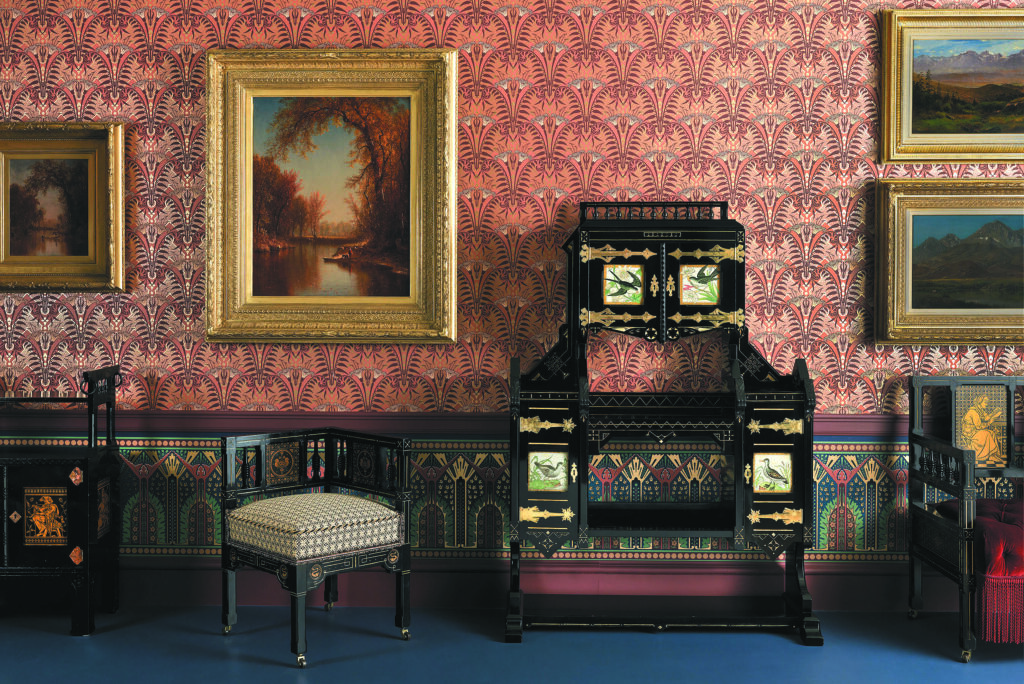
Installation view of Aesthetic Splendors: Highlights from the Gift of Barrie and Deedee Wigmore, an exhibition that ran from 2019 to 2021 at the Metropolitan Museum of Art. Arnaud photograph, courtesy of the Metropolitan Museum of Art.
Eventually other art dealers wised up and began to compete with Wigmore for work from the figurative artists of the Thirties, and she expanded her purview to include abstractionists from before and after the Second World War. They range from those among the cosmopolitan Park Avenue cubists of the 1930s, such as George L. K. Morris and Albert Gallatin, to artists like Ilya Bolotowsky—Wigmore’s holdings include his wonderful geometric mountain-scape Centennial, which reflects his time as a college art teacher in Wyoming—and Irene Rice Pereira, a pioneering abstractionist whose work, Wigmore says, “was about light, time, and space” and who will be the subject of an exhibition at the gallery later this year. “I like to have both realist and abstract work in the gallery, to show how the paintings can speak to one another. They say something about the time they were made, the people who made them, and the places they were made.”
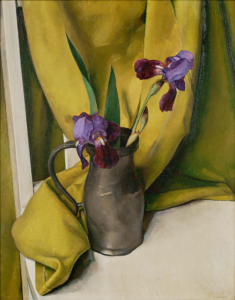
Iris by Luigi Lucioni (1900– 1988), 1927–1928. Allum photograph.
Beyond providing art interpretation, Wigmore says that she and gallery director Emily Lenz have a more fundamental mission, grounded in research and scholarship. “Our customers are both museum people and collectors, and our goal is to make each one of them look like a genius,” she says. “So we have to do our part to show that what we offer them is good in every way.”
Frelinghuysen will happily attest that Wigmore has helped her look astute. She likes to tell a story of the time she spotted an aesthetic movement table by the Philadelphia firm A. and H. Lejambre in a New York antiques shop. The piece had been ebonized, but Frelinghuysen suspected that the finish concealed some of Lejambre’s signature insect-motif inlays. Wigmore plunked down the money to purchase the table, and conservators later proved Frelinghuysen’s hunch correct. The table, which features an inlaid dragonfly and butterfly, is now in the Met’s collection. “Deedee was willing to take a risk,” Frelinghuysen says. “That wasn’t the sort of thing most people do.”
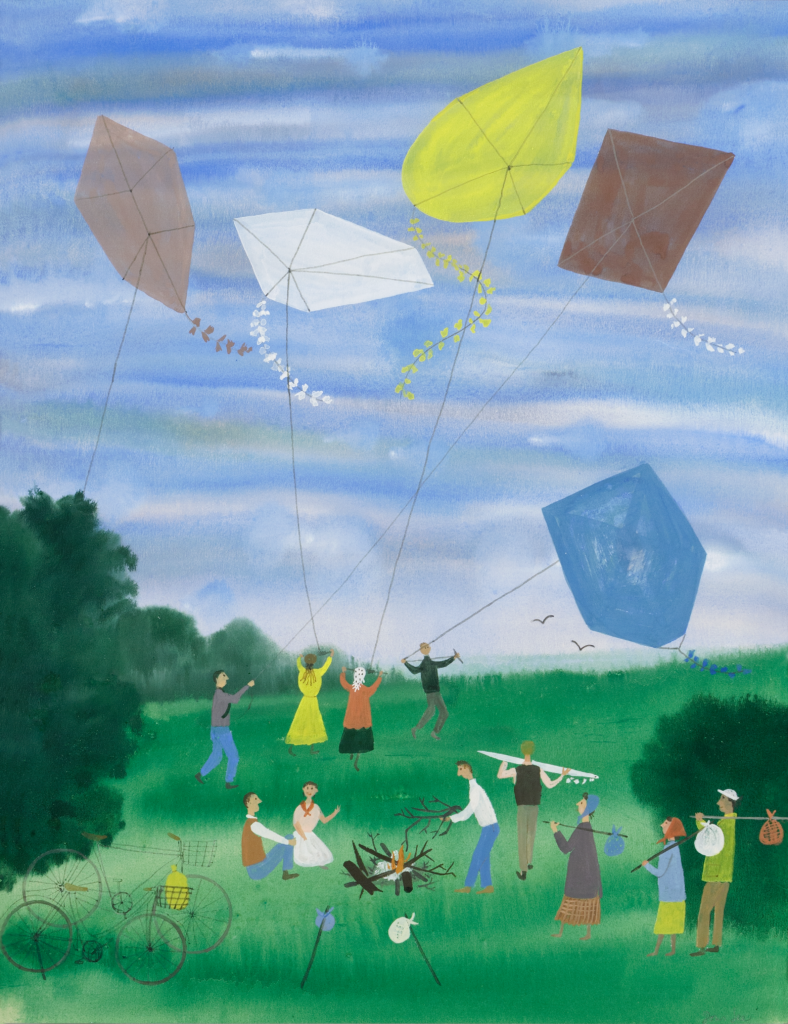
High Flying Picnic by Doris Lee (1904– 1983), 1950. Allum photograph.
The excellence of the collection of fine and decorative artworks from the Gilded Age that the Wigmores assembled in their meticulously restored home in the Dakota apartment building has been well documented. It includes pieces from the top furniture makers of the American aesthetic movement— among them Herter Brothers, Kimbel and Cabus, and Daniel Pabst—and paintings by such Hudson River school luminaries as Sanford Gifford, George Inness, and Albert Bierstadt. The collection was the subject of a lengthy feature in our pages (“Aesthetic Appeal,” by Barrymore Laurence Scherer, January/ February 2020) that was published during the run of the Met exhibition Aesthetic Splendors: Highlights from the Gift of Barrie and Deedee Wigmore—a showcase, curated by Frelinghuysen and Elizabeth Mankin Kornhauser, for some fifty objects and paintings from a promised gift of eighty-eight artworks. The Wigmores have been Met benefactors since the 1980s, funding exhibitions, projects, and acquisitions. They endowed the Deedee Wigmore Galleries in the American Wing in 1999, and Barrie Wigmore was elected to the museum’s board of trustees in 2002. “Deedee and her husband have been true angels,” Frelinghuysen says. “They have been transformative to the Met’s galleries.”
Though she has helped build the collections of other New York art institutions—notably that of the Brooklyn Museum—Wigmore says that the Met “is a special place. It gave me a real education.” Like others she knows, she says, “When I stood in front of that Herter Brothers wardrobe in the American Wing, the one that supposedly came from Lillian Russell, I had an epiphany. I knew that was what I wanted to collect.”
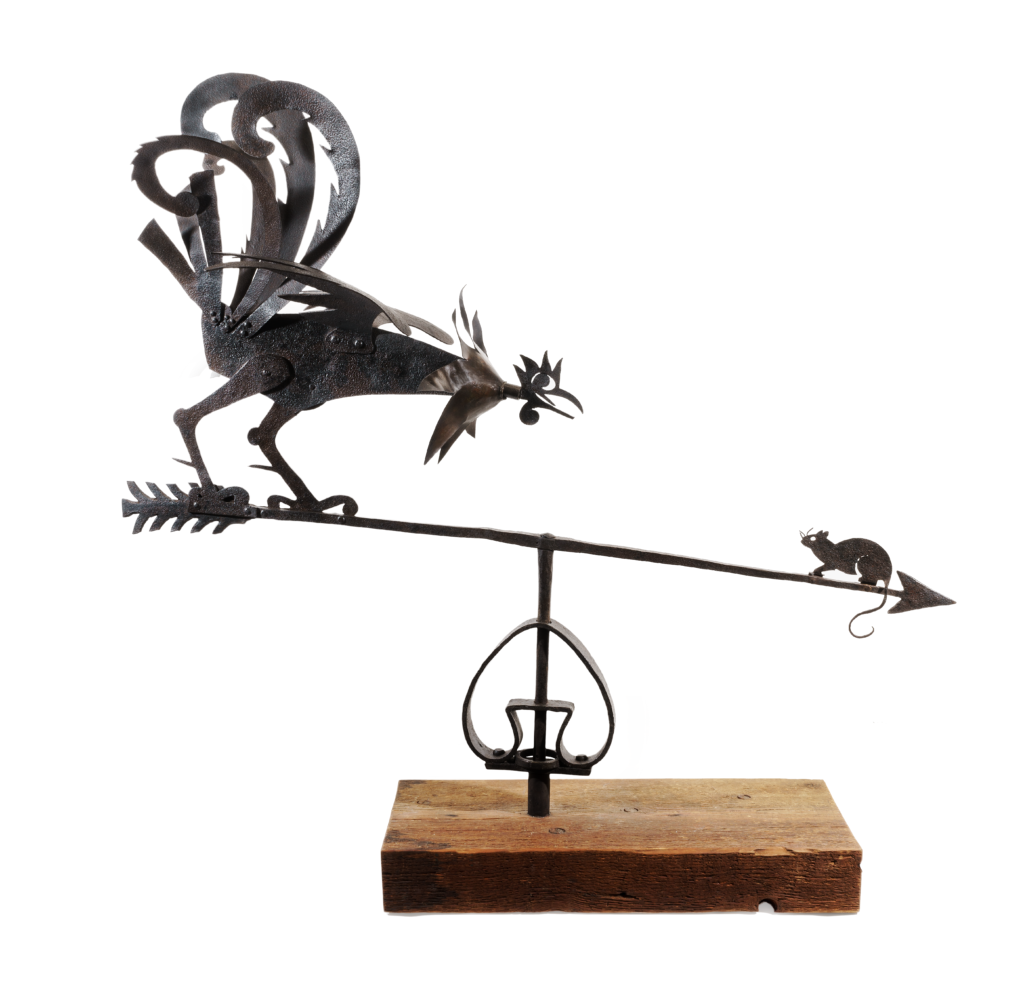
Rooster and mouse weathervane made by W. Hunt Diederich (1884– 1953), c. 1917. Allum photograph.
Still, to most eyes, a Herter Brothers cabinet and a Bierstadt landscape don’t belong in the same conversation with a Doris Lee outdoor scene and a Hunt Diederich weathervane. How does Wigmore manage to appreciate such starkly different works of art as those she collects and those she offers in her gallery? “Art is a continuum. If you love the art of one period, you love the way it affected things down the way a bit in time,” she explains. “You become open to and respectful of what each generation of artists did and is doing. You spot re-interpretations and reexaminations. It keeps you fresh.”

